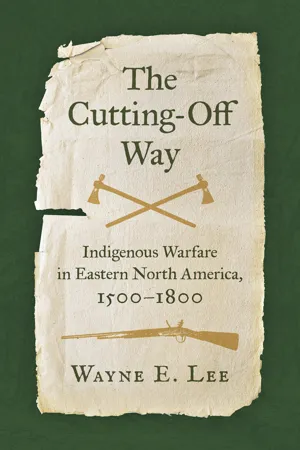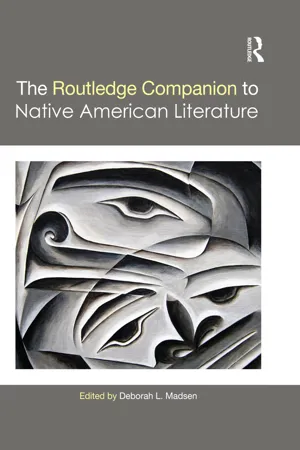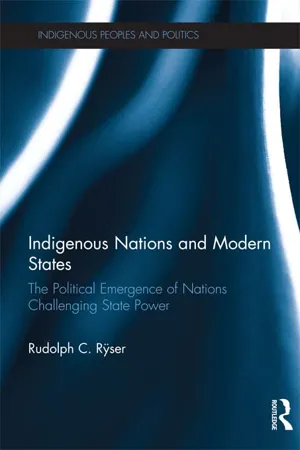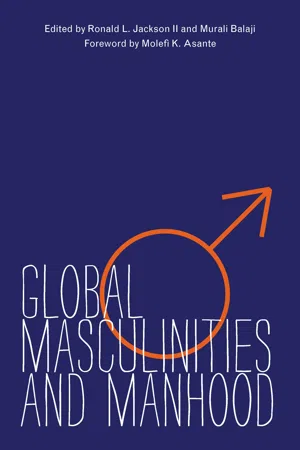History
Native American Wars
Native American Wars refer to a series of conflicts between indigenous tribes and European settlers and the United States government. These wars were fought over land, resources, and cultural differences, and resulted in significant loss of life and displacement of Native American populations. The conflicts were complex and varied, with different tribes and regions experiencing distinct patterns of warfare.
Written by Perlego with AI-assistance
Related key terms
5 Key excerpts on "Native American Wars"
- eBook - ePub
The Cutting-Off Way
Indigenous Warfare in Eastern North America, 1500–1800
- Wayne E. Lee(Author)
- 2023(Publication Date)
- The University of North Carolina Press(Publisher)
And because of European colonialism, very many of the wars that we see most clearly were in fact Native wars of self-defense, which need little explanation. As for wars among Indian Nations, European witnesses often imagined them as simply about revenge (communal and personal) or individual prestige. Some modern scholarship suggests that the desire to dominate new trade possibilities created by the arriving Europeans led to an expansion of wars among Indians competing for trade routes and hunting territories. Other scholars argue instead that cultural motives were more important — notably the desire to take prisoners for adoption and to both grieve losses and restore populations wracked by war and epidemics. 2 We also have clearly seen inter-Indian wars generated by European eagerness to trade goods for Indian slaves, at least through the early eighteenth century. 3 It therefore seems unavoidable that we ascribe at least some of the postcontact inter-Indian conflicts to a desire to access European goods in one way or another. Nevertheless, even when scholars have acknowledged that warfare was common and socially significant in relations among Native American Nations, there has been a tendency to avoid being clear about its political function. Timothy Pauketat, for example, a leading expert on Mississippian chiefdoms, after describing a carving of one Mississippian warrior killing or scalping another, somewhat inconclusively suggests that “this sort of warfare was probably intended to intimidate an enemy if not also to achieve a strategic military goal.” 4 More usefully, some ethnohistorians have begun to emphasize sovereignty, stressing that Native Nations made territorial claims and defended them. But even that emphasis on Native defense of sovereignty remains focused on the problem of survival in the face of European incursions and thus limits our understanding of how Native Nations imagined the political outcomes of offensive war - Jennifer Haytock(Author)
- 2018(Publication Date)
- Routledge(Publisher)
1 and the Revolutionary War, the earliest writings that can be considered “American war literature,” helped shape the identity of the nation and laid the groundwork for a literature that would become essentially “American,” a tradition distinct from its British roots. As we know, the stories of violent conflicts tend to be written by the victors, who define the terms and the stakes of the war. In the case of the on-going suppression, dislocation, and extermination of the continent’s indigenous peoples, European authors who described the barbarity of the Indians felt justified, often by the Christian God, by the belief that they were building a “civilized” nation. In the case of the Revolutionary War, writers who argued for the colonists’ independence from England sought to outline a new national American character as well as principles of both private and public life. In both wars, however, the losing side wrote back, and although these voices are less well known today, their rhetoric has its own power and value. American Indians produced a body of literature protesting the injustices of the settlers’ and later the U.S. government’s attitudes and policies, including broken treaties, physical invasion, and the slaughter of women and children, not just warriors. Loyalists to the English crown used a variety of printed forms to argue for the illegitimacy of a break with Britain and often mocked the pretensions of those who sought to form a new government. While these sets of literature address different wars and cover different, though overlapping, periods in American history, it’s worthwhile to examine them in the same chapter because at the center of both literatures are issues of human rights, the violence enacted to secure or deny them, and the long-lasting consequences of that violence and the rhetoric that justified it.Literature of the Indian Wars
The conflict, or rather series of conflicts, between Native Americans and Europeans is the longest-running war in American history, beginning with the arrival of Columbus in 1492 and the Spanish conquistadors in the sixteenth century and then with the settling of the first English colonies in the seventeenth century. These wars were also some of the bloodiest, with some conflicts becoming massacres of whole settlements, many tribes displaced onto some of the least hospitable lands on the continent, and many native languages and cultures wholly obliterated. In fact, the conflicts may be considered genocide rather than wars. While today most Americans usually know something about the Revolutionary War, they tend to be less familiar with the Indian Wars, but this was not always the case. As Cheryl Walker argues, “by the 1830s Indian wars had come to seem central to the building of the nation” (167). European Americans often identified themselves specifically in contrast to Native Americans, whose defeat seemed a justification of the God-ordained presence of white people and their culture in the New World.These wars were also fundamental to the economic success of European Americans. The newcomers wanted the land and resources of the American continent, and they took them, imposing their idea of ownership on the indigenous peoples, to their detriment. Although it’s risky to generalize about “Native Americans,” as the continent was populated by many tribes with different cultures and languages, most of these tribes believed that humans were given the use of the land in trust; they could not own or sell it. The European invaders, with their alien ideas about property ownership, access to superior weaponry, and resistance to diseases that decimated Indians, imposed new practices that forced the original inhabitants further and further west. The most famous of these removals was the Trail of Tears, the forced march of several Indian tribes, including the Cherokee, Choctaw, and Seminole, among others, from their lands in the southeastern part of the United States to present-day Oklahoma, as ordered by the Indian Removal Act of 1830. The wars against the Indians continued in a variety of forms, including the removal of children from their parents to government-run boarding schools. This practice broke up families and caused the loss of native languages, religions, and cultures and was only ended in the 1970s.- Deborah L. Madsen, Deborah L. Madsen(Authors)
- 2015(Publication Date)
- Routledge(Publisher)
11 Native Letters and North-American Indian Wars Oliver Scheiding DOI: 10.4324/9781315777344-11 In light of current scholarship that refocuses Native agency in the context of “The Red Atlantic” (Weaver), this chapter surveys selected key moments in the history and literature of Indian upheavals to discuss representations of North American Indian struggles on historical levels as well as on the level of the personal depicted in social conflict or in conflict with the self. In doing so, the chapter looks at Native responses to warfare as more than defensive strategies of resistance and containment. Instead, I will consider different genres used by Native American writers to re-evaluate the complex intersections among Native peoples, Euro-American powers, borderlands, and homelands. The opening pages of Leslie Marmon Silko’s epic text, Almanac of the Dead (1991), reprints what she calls the “Five Hundred Year Map” of European and Native American encounters with the claim that “The Indian Wars have never ended in the Americas” (n. pag.). Such statements show that both “non-Indians and Indians have different stakes in the history of the Indian Wars” (Elliott 15). What also becomes obvious is the fact that besides the fascination of war and violence, the Indian Wars had a formative impact on print, writing, and literature. From the earliest local clashes in the sixteenth and seventeenth centuries, to the French and Indian Wars (1754–1763) that was part of a worldwide imperial conflict, and to the more than forty battles against Native Americans in the nineteenth century, the many Indian wars produced countless pamphlets, sermons, petitions, letters, newspaper reports, poems, and plays that shaped public history and popular forms of memorialization, as discussed by Michael Elliott in his seminal study on the enduring legacy of the Indian Wars and General Custer’s defeat at the Battle of the Little Bighorn- eBook - ePub
Indigenous Nations and Modern States
The Political Emergence of Nations Challenging State Power
- Rudolph C. Ryser(Author)
- 2012(Publication Date)
- Routledge(Publisher)
7 FOURTH WORLD WARS IN THE SHADOWS I turn now to an examination of what the popular press calls “ethnic conflicts” or “ethnic wars” that have become widely associated with terrorist attacks—a convenient rationale for harsh suppression of indigenous peoples. In the words that follow, I suggest another view: the vast majority of these conflicts between nations and between nations and states are not simply outbursts of emotional hatred, and they aren’t terror-crazed haters of western civilization eager to kill civilian populations. Rather, they are a part of an historic process of nations defining their political status in the international arena while establishing or forming new social, economic, and political institutions of governance: processes I refer to as nationcraft and political transformation. By stabilizing relations with surrounding states nations choose their political future and form of governance without outside impediments. This is a right guaranteed by virtually all international conventions. While the international community grants the right to political self-determination for colonized peoples, individual nations inside existing states rarely make gains toward self-determination without a political struggle. When the political process fails to achieve self-determination, indigenous nations and states frequently engage in violent confrontations. Despite the new international standards (such as those contained in the United Nations Declaration on the Rights of Indigenous Peoples) where indigenous peoples are supposed to have the right of self-determination and to have decisions about their interests made after the exercise of “free, prior and informed consent” (see Appendix A), military forces continue to oppose nations exercising this important political right. The use of violence or coercion against nations seeking to achieve political change works to prevent the political transformation of nations - eBook - ePub
- Ronald L Jackson, Murali Balaji, Ronald L Jackson, Murali Balaji(Authors)
- 2011(Publication Date)
- University of Illinois Press(Publisher)
In the broader context of Native American studies, bringing the past into rigorous reflection can help to provide more ethical approaches to shared history. As Elmer Kelton writes, “A common misconception regarding America’s Plains Indians is that their cultures had existed with little change for ages before the white man’s intrusion” (Kelton, 1993, p. 50). Another common misconception is that indigenous peoples on the Plains lived in harmony with nature and with one another, with a relatively homogeneous culture. On the contrary, a historical survey of even a small part of Plains culture yields clear indications that not only were these groups quite different from one another, but also that the cultures themselves evolved in form. The Northern Plains, for instance, constituted a highly contested space before the reservation era, one with a very long history of trade, cultural adaptation, and both the clashing and blending of traditions (Harrod, 1995). The “clashing” certainly included intertribal warfare.Written records of this period are nonexistent, but winter counts (pictorial representations of tribal histories) and oral traditions suggest the existence of a highly developed warrior ethic. War may be described for some societies, especially those on the Northern Plains, as a spiritual activity that included its own formal ceremonies. Dancing would have been part of these rituals. Significant to my purposes in this chapter, it is clear from historical documentation that the modern-day powwow has grown out of the tradition of war dancing on the Plains (Powers, 1990; Kracht, 1994; Ellis, 1999). Significantly, war dancing continued during the reservation period when the actual act of warfare was discontinued. The moving of Native Americans onto reservations (some as early as the 1820s, the last in the mid-1890s) definitively marked the end of the “Indian Wars” in America. Certainly, the desire of Native Americans to continue the ceremonies pertaining to war may have stemmed from a natural resentment toward their American enemies and a frustration at being confined to reservations without weapons or freedom. Some dances, such as the Ghost Dance on the Plains, were pure religious ceremonies designed to bring about victory over white Americans. Others, though, may have had a less direct rhetoric but were still intended to preserve the “warrior ethic” so intertwined with specific Native American cultures. Some government representatives on the Indian agencies and later reservations responded with paranoia toward this war dance heritage, interpreting “cultural revitalization as a political conspiracy” (Gump, 1997, p. 35). But from the perspective of war dancers, giveaway donors, and other celebrants, attempts to suppress dancing and the giveaway were an attack on religious freedom (Williard, 1991).
Index pages curate the most relevant extracts from our library of academic textbooks. They’ve been created using an in-house natural language model (NLM), each adding context and meaning to key research topics.




